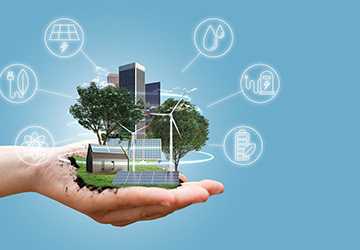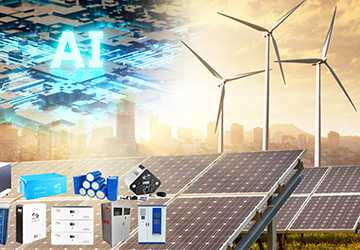The Future of Renewable Energy Technology
Renewable energy technology stands at a critical moment in history. As we confront the dual challenges of climate change and finite fossil fuel resources, the need for sustainable, clean energy solutions has never been more pressing. The prospects of renewable energy technologies promise groundbreaking innovations that could redefine how we power our world. Let's explore the key advancements that will shape the future of renewable energy.

Solar Power: Beyond Panels
Solar energy has already made significant strides, but the future holds even more promise. The efficiency of photovoltaic (PV) cells is increasing at an impressive rate, fueled by material innovations like perovskite solar cells. These cells promise higher efficiency at a lower cost, making solar power more accessible and practical for widespread use.
Moreover, the development of solar skins and transparent solar panels means that almost any surface can be turned into an energy generator. Imagine windows, building facades, and even cars harnessing the sun's power. This integration will reduce our reliance on traditional power grids and create energy-autonomous buildings and vehicles, a significant step in future clean energy technology.
Key Innovations in Solar Power
● Perovskite Solar Cells: Higher efficiency and lower cost.
● Solar Skins and Transparent Panels: Turning any surface into an energy generator.
● Energy-Autonomous Structures: Buildings and vehicles powered independently.
Wind Energy: Harnessing the Air
Wind power is another cornerstone of renewable energy technology. Offshore wind farms and aerial wind turbines are the future wave for wind energy. Offshore wind farms can capture stronger and more consistent winds over the ocean, significantly increasing energy output.
Airborne wind turbines, like those developed by companies like Makani, harness wind energy at higher elevations where winds are more consistent and powerful using kites or drones. Regarding future clean energy technology, these turbines can generate twice the power of conventional wind turbines while requiring less material and land space.
Future Directions in Wind Energy
● Offshore Wind Farms: Stronger and more consistent winds over the ocean.
● Airborne Wind Turbines: Utilizing high-altitude winds for greater efficiency.
● Material and Space Efficiency: Less material and land required for turbines.
Energy Storage: The Game Changer
One of the biggest challenges with future clean energy technology is storage. Because solar and wind energy are sporadic, reliable electricity must be provided through adequate storage. Technology developments in batteries, especially solid-state batteries, have the potential to transform energy storage completely. Compared to existing lithium-ion batteries, these batteries provide improved energy density, longer lifespans, and increased safety.
Another positive trend is the application of large-scale energy storage technologies like pumped hydro storage and molten salt storage. By storing energy during high-output periods and releasing it during low-demand periods, these systems have the potential to provide a steady supply of energy.
Advances in Energy Storage
● Solid-State Batteries: Higher energy density, longer lifespan, more excellent safety.
● Pumped Hydro Storage: Large-scale energy storage for peak production times.
● Molten Salt Storage: Efficient storage and release of energy.
Smart Grids: The Backbone of Future Energy Systems
The conventional power grid must change as renewable energy sources become more widespread to support the prospects of renewable energy technologies. Integrating renewable energy into our current infrastructure requires intelligent grids, which monitor and control energy flows using digital technologies. These grids make real-time supply and demand balancing possible, energy waste reduction, and improved power system dependability.
Benefits of Smart Grids
● Real-Time Energy Management: Balancing supply and demand efficiently.
● Reduced Energy Waste: Enhancing overall energy efficiency.
● Decentralized Energy Production: Enabling local generation, storage, and energy sharing.
Hydrogen: The Clean Fuel
Many people praise hydrogen as the fuel of the future. Hydrogen is an entirely pure energy source, as it only generates water as a byproduct when used in fuel cells. For hydrogen to be widely used, effective and affordable manufacturing, storing, and transporting processes must be developed.
Electrolysis, increasingly economical and efficient, divides water into hydrogen and oxygen. When fueled by renewable energy sources, this method can generate green hydrogen, providing a sustainable substitute for fossil fuels in transportation and industry; this is a significant step in the prospects of renewable energy technologies.
Hydrogen Advancements
● Fuel Cells: Clean energy with water as the only byproduct.
● Efficient Electrolysis: Improved methods for producing green hydrogen.
● Storage and Transport: Innovations in handling hydrogen efficiently.
The Role of Artificial Intelligence
Artificial intelligence (AI) is poised to play a significant role in the future of renewable energy. AI can optimize energy production, storage, and consumption by analyzing vast data and making real-time adjustments. For instance, AI can predict energy demand patterns, optimize the operation of wind turbines and solar panels, and improve the efficiency of energy storage systems.

Moreover, AI-driven predictive maintenance can reduce downtime and extend the lifespan and prospects of renewable energy technologies, improving their reliability and cost-effectiveness.
AI in Renewable Energy
● Optimization: Enhancing production, storage, and consumption.
● Predictive Maintenance: Reducing downtime and extending infrastructure lifespan.
● Data Analysis: Real-time adjustments for improved efficiency.
The Path Forward
The transition to renewable energy has its challenges. It requires substantial investment, supportive policies, and global cooperation. However, the potential benefits are immense. Renewable energy technology can reduce greenhouse gas emissions, create jobs, and improve energy security.
To accelerate this transition, governments and businesses must invest in research and development, support the deployment of new technologies, and create regulatory frameworks that encourage innovation and adoption. Public awareness and acceptance are also crucial; educating people about the benefits of renewable energy and dispelling myths and misconceptions can drive demand and support for these technologies.
Steps to Accelerate Transition
● Investment in R&D: Funding for new technologies.
● Supportive Policies: Regulatory frameworks to encourage innovation.
● Public Awareness: Educating and garnering support for renewable energy.
Conclusion
The outlook for clean energy technology is bright. Innovations in solar and wind power, energy storage, smart grids, hydrogen fuel, and AI are set to transform our energy systems. By accepting these advancements, we can build a sustainable, clean energy future that benefits the planet and its inhabitants. The path ahead is challenging, but with determination and innovation, we can achieve a world powered by renewable energy.